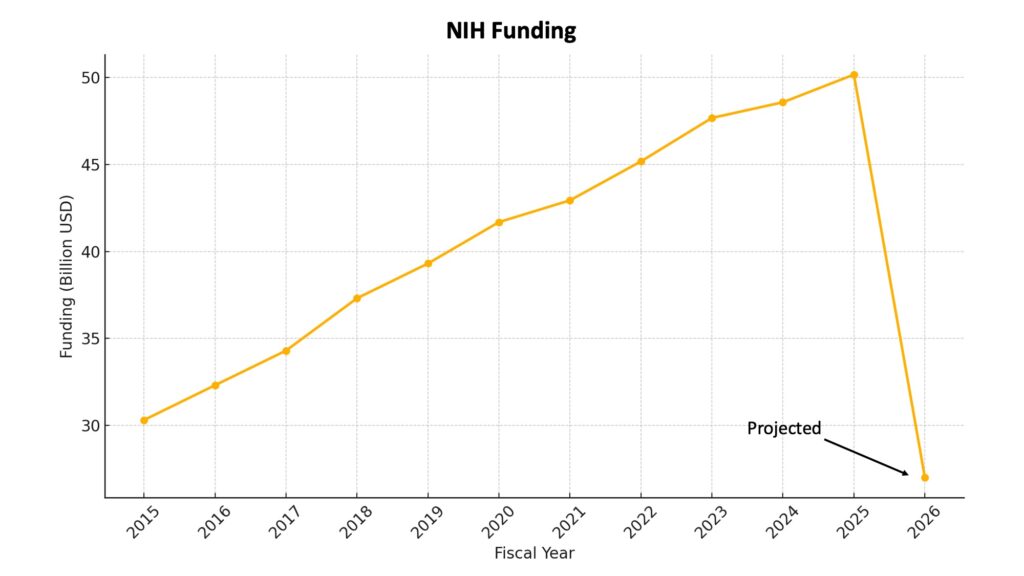Introduction
Since Donald Trump returned to the White House in 2025, his administration has moved swiftly to cut federal support for science. Across agencies, research funding cuts are being implemented or proposed in ways that critics say will make Americans insidehighered.com. For example, the National Institutes of Health, the National Science Foundation, and climate and space research programs are all facing reductions. According to analysts, the scope of these research funding cuts is unprecedented in modern U.S. history insidehighered.com spaceflightnow.com.
In this post, I’ll break down how these cuts target key scientific fields—and explore what the consequences might be for America’s health, economy, and future.
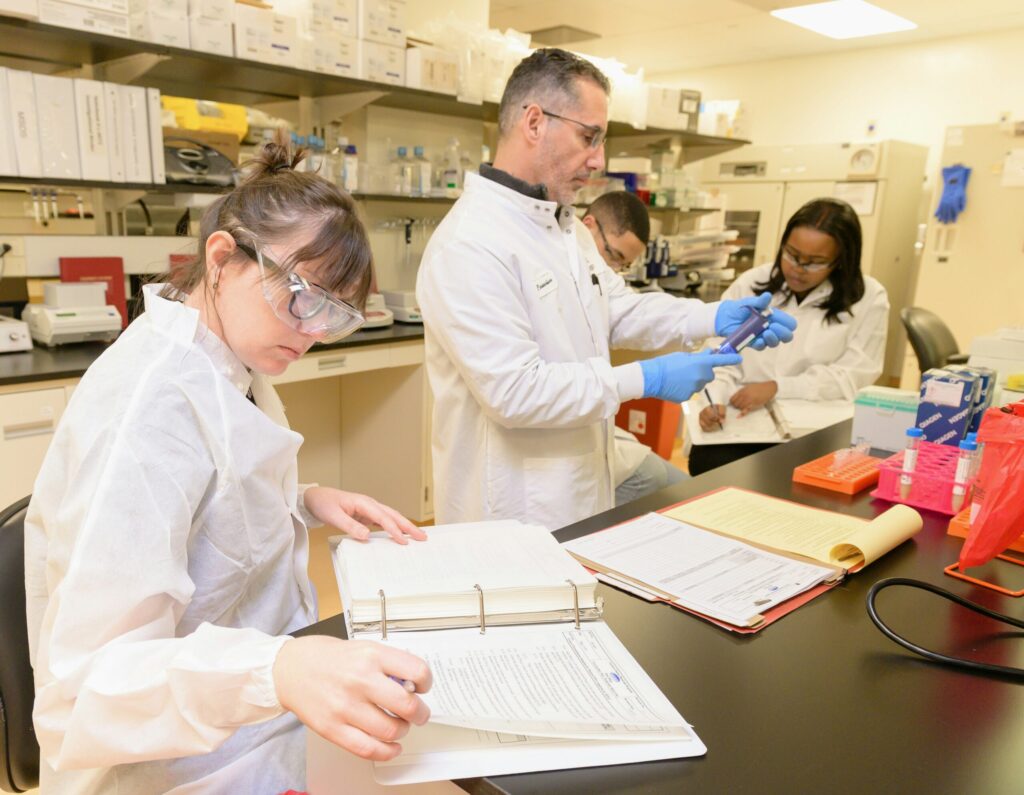
Advocates warn that steep research funding cuts could undermine America’s health innovations and scientific leadership. National institute of Allergy and Infectious Diseases via Unsplash.
Biomedical Research: Targeted and Undermined by Research Funding Cuts
NIH Under Siege
Historic Research Funding Cuts to a Cornerstone of Biomedical Science
Trump’s 2026 budget proposal includes research funding cuts that slash the NIH by nearly 40%, a cut of around $18 to $20 billion, according to Inside Higher Ed and Harvard Kennedy School analyses. Internal HHS documents detail plans to shrink the agency from 27 institutes to just 8. Several specialized institutes would be eliminated entirely. Even the major survivors, like the National Cancer Institute and NIAID, would still absorb deep research funding cuts. NCI’s budget would fall from $7.2 billion to $4.5 billion; NIAID’s from $6.6 billion to $4.2 billion Inside Higher Ed. In total, NIH discretionary funding would shrink to $27–29 billion, marking its lowest inflation-adjusted level since the early 2000s Harvard Kennedy School.
By early April 2025, the impact of these research funding cuts had already become visible. NIH had canceled or frozen $2.4 billion in research grants and contracts. Over 1,200 staff had been laid off. A hiring freeze was in effect. Meanwhile, academic medical centers reported halted job offers and postponed clinical trials.
Ideological Pressure and the Threat to Scientific Integrity
The administration also tried to cap university overhead (indirect costs) at 15%—a move that would have pulled billions from institutional budgets. A federal judge blocked it after a lawsuit filed by universities and state governments.
Even more troubling, the administration began threatening to withhold all NIH funding from universities unless they revised admissions, hiring, and curriculum policies. None of these demands were related to biomedical research (Harvard Kennedy School). In a JAMA Forum piece, this was described as an “ideological litmus test” that sent a chill through academic science. “Scientists researching new cancer cures are neither culture warriors nor campus protesters,” two Harvard economists wrote. “But they are the ones being punished.” hks.harvard.edu
As someone who spent years in biomedical research, I find this deeply unsettling. Breakthroughs—whether in cancer vaccines or Alzheimer’s treatment—depend on sustained investment. Sudden research funding cuts bleed away both momentum and talent.
A coalition of scientific organizations warned that the proposal could reverse decades of medical progress. “If enacted, the FY26 budget request would end America’s global scientific leadership,” said AAAS president Sudip Parikh. “It would imperil our future health, security, and prosperity” insidehighered.com. Furthermore, one analysis even projected a potential $8 trillion long-term hit to the U.S. economy and health outcomes jamanetwork.com.
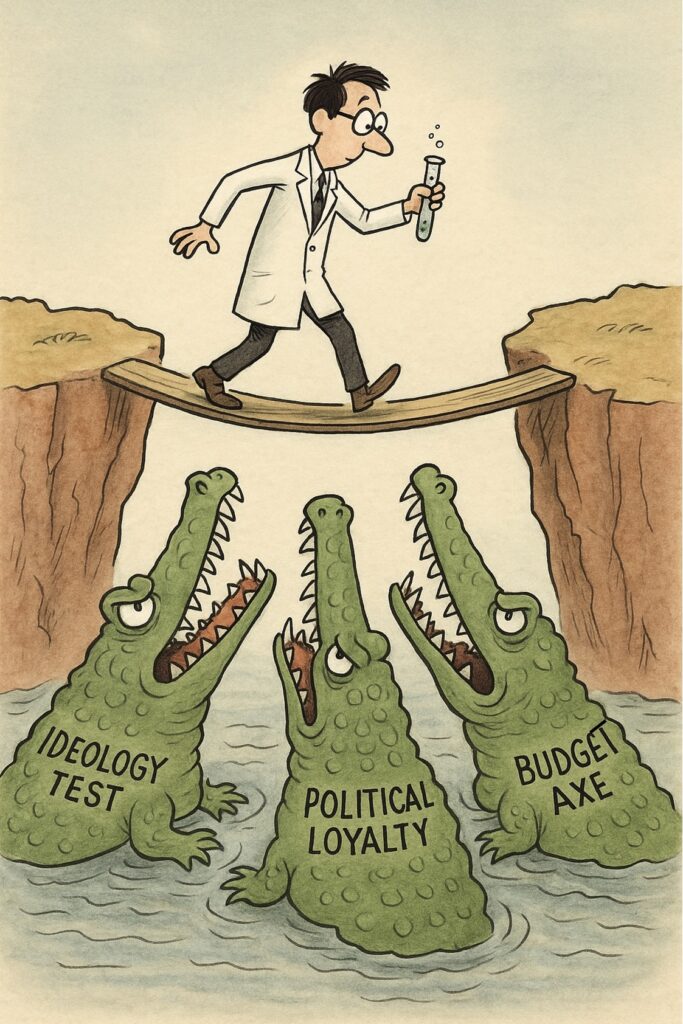
NSF and STEM Training Slashed
Severe Research Funding Cuts to the NSF
The National Science Foundation now faces a similarly steep reduction—a 57% cut, dropping from over $9 billion in 2024 to just $3.9 billion insidehighered.com.
Crucially, programs that support the next generation of scientists stand to lose the most. Specifically, the administration plans to eliminate 8 out of 10 postdoctoral fellowships and slash funding by up to 91%. In addition, the NSF Research Traineeship for graduate students would be canceled, along with REU, the decades-old undergraduate research initiative.
Widespread Impact on Equity and Innovation
Even worse, efforts to broaden access in science—those supporting women, minorities, and underserved communities—would be nearly wiped out. Specifically, these initiatives would shrink from $1.6 billion to just $171 million. As one analysis put it bluntly: “Future generations will likely have fewer scientists who are equipped to make advances.” insidehighered.com
Meanwhile, biologist Joshua Weitz of the University of Maryland described the combined NIH and NSF research funding cuts as “catastrophic.” He warned that they could set the U.S. research landscape back 25 years. More urgently, he predicted widespread economic and job losses insidehighered.com. And the numbers back him up. Public R&D spending typically yields an estimated 140–210% return on investment. In short, cutting research is both short-sighted and economically self-destructive. These research funding cuts threaten to squander future growth at a national scale.
The FDA Is Quietly Hollowed Out
Staff Cuts Cripple Oversight and Safety
The FDA—while not typically a grantmaker—has still faced serious setbacks. The agency has already laid off over 3,500 staff, amounting to a roughly 20% reduction brookings.edu. As a result, analysts warn these losses will slow down drug approvals, reduce inspections, and strain the entire regulatory system that ensures treatments remain safe and effective.
Undermining Public Trust in Science
The administration attempts to justify the cuts by citing “excessive bureaucracy.” However, those working inside the system aren’t convinced. “Weakening the FDA’s scientific capacity will negatively impact patients,” experts told Brookings brookings.edu.
When combined with NIH research funding cuts, the intent is clear: this is a coordinated attack on the entire scientific infrastructure that moves discovery from the lab to the clinic.
In the end, these actions place public health at direct risk.
Climate Science in Retreat
NOAA Gutted by Research Funding Cuts
One of the hardest-hit agencies is the National Oceanic and Atmospheric Administration (NOAA). Trump’s 2025 budget proposal implements a 27% cut to NOAA’s overall funding—an enormous reduction for an agency responsible for forecasting weather, tracking storms, and monitoring climate.
According to a leaked memo from the Office of Management and Budget, the administration plans to eliminate “almost all functions…related to the study of climate change.” Specifically, NOAA’s Office of Oceanic and Atmospheric Research (OAR) would lose 74% of its budget, which would effectively shut it down as a functioning branch. In particular, this includes defunding the Geophysical Fluid Dynamics Laboratory (GFDL), a Princeton-based center that helped build global climate models. As a result, atmospheric scientist Don Wuebbles summed up the danger clearly: “If we don’t understand what’s happening and why, you can’t be adapting, you can’t be resilient. You’re just going to suffer” propublica.org
Forecasting Capacity Crippled
Already, the effects of these research funding cuts are visible. In February, NOAA fired hundreds of employees overnight—about 10% of the entire agency.
Then in March, the National Weather Service announced it would reduce or suspend weather balloon launches at 11 stations due to staffing shortages. These balloons are crucial for collecting upper-atmosphere data used in daily forecasts and storm tracking. In some states, balloon launches have stopped entirely gizmodo.com.
Experts now warn the result will be less accurate hurricane and storm forecasts—a serious risk just as NOAA predicts an above-normal Atlantic hurricane season cfr.org.

Research Funding Cuts put USGS Climate Centers on the Chopping Block
The U.S. Geological Survey (USGS) is now facing deep research funding cuts. Specifically, the proposed budget calls for eliminating its $326 million ecosystems research program, which currently funds all nine Climate Adaptation Science Centers across the country.
These centers, in turn, play a critical role in helping communities plan for climate impacts such as sea level rise, invasive species, and salt marsh erosion. As Bethany Bradley of the Northeast center at UMass Amherst put it: “If you like to fish, if you like to walk in the forest, you should care about these cuts,” wbur.org.
Energy Research Redirected to Fossil Fuels
The Department of Energy’s clean energy research budget is also taking a major hit. The Office of Energy Efficiency and Renewable Energy (EERE) would lose 74% of its funding hklaw.com. Meanwhile ARPA-E, known for pioneering high-risk, high-reward energy innovation, would be cut by 57%.
In sharp contrast, fossil energy programs for oil, gas, and coal are being preserved and rebranded under the banner of “energy dominance.” The phrase “carbon management” is even being removed from Department of Energy materials altogether hklaw.com.
NASA Satellites Face Elimination
NASA’s Earth Science Division is also on the chopping block. Several climate-monitoring satellites are now set for cancellation, even as 2024 was officially declared the hottest year on record spaceflightnow.com.
The logic is deeply flawed: as climate extremes intensify, the U.S. is actively dismantling the very tools it needs to understand and respond to them.
Research Funding Cuts are Rapidly Eroding Climate Expertise
Veteran scientists are already walking away. At NOAA, researchers are retiring early in response to these destabilizing research funding cuts. One told The Guardian, “These problems don’t go away because we fired the people solving them. The core is dying” theguardian.com
Across agencies, scientists now fear a brain drain, as climate modelers and adaptation experts either leave public service or move abroad. The long-term consequences could be severe: less knowledge, fewer warnings, and far greater risk.
Space Exploration and Science Slashed
Deep Research Funding Cuts Across NASA
NASA hasn’t escaped the axe of research funding cuts. Trump’s FY2026 budget proposes slashing NASA’s funding by 24%, dropping it from $24.8 billion to $18.8 billion, its lowest (adjusted) level since 1961 space.com. As a result, over one-third of NASA’s science missions could be eliminated or scaled back. The Planetary Society reports that 41 projects are now on the chopping block planetary.org. Programs at risk include the Mars Sample Return mission, the New Horizons probe, and the Juno orbiter at Jupiter. Even two key Mars orbiters—MAVEN and Odyssey—face shutdown space.com
Science Directorate Hit Hardest
NASA’s Science Mission Directorate bears the brunt of these research funding cuts. Its budget would drop by 47%, from $7.4 billion to $3.9 billion. space.com
Earth science suffers especially sharp losses. The White House has called for the elimination of climate monitoring satellites—even as NASA confirms that 2024 was the hottest year on record spaceflightnow.com.
The next-generation Nancy Grace Roman Telescope avoids cancellation, but its development funding is slashed—likely delaying launch space.com.
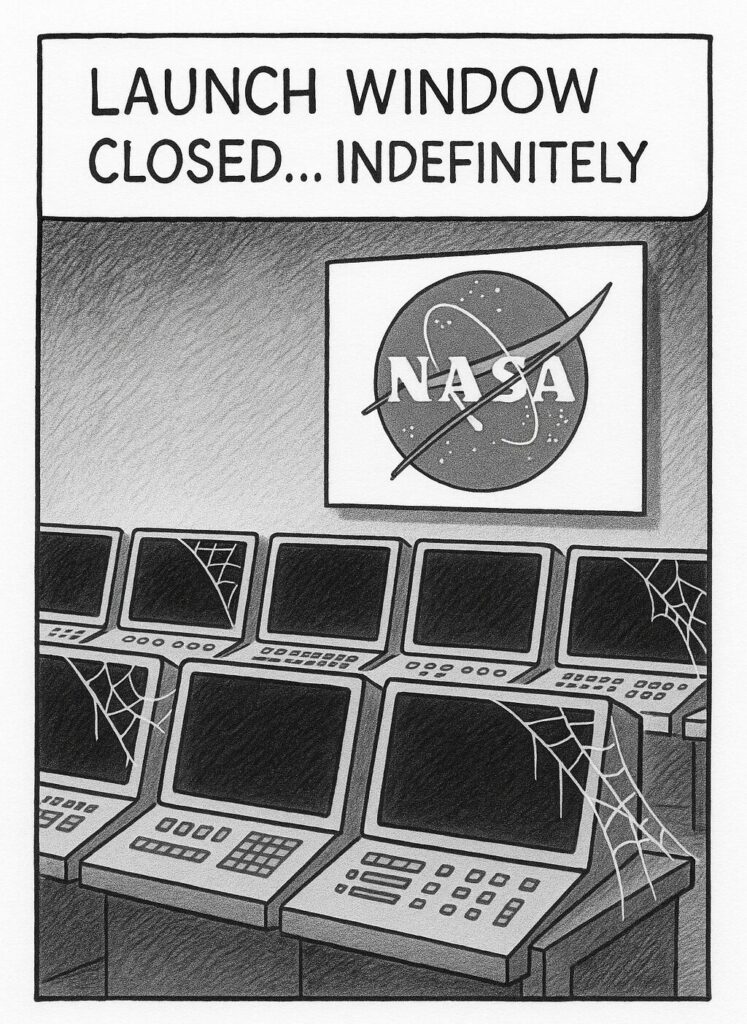
STEM and Outreach Programs Scrapped
The proposed budget also eliminates NASA’s Office of STEM Engagement, ending most education and outreach programs. These efforts have long helped inspire students to pursue science and engineering careers space.com.
The administration claims NASA’s “missions alone” will inspire the public. However, scientists question that assumption.
Artemis Hardware on the Chopping Block
Interestingly, human exploration receives a funding boost. Over $7 billion is earmarked for lunar missions, with $1 billion newly added for future Mars flights spaceflightnow.com.
But there’s a catch. The budget calls for terminating the Space Launch System (SLS) and Orion spacecraft after just three Artemis missions. It also scraps the Gateway lunar station, once central to long-term Moon exploration.
The administration says SLS and Orion are too expensive at $4 billion per launch, and wants NASA to rely on private rockets, like SpaceX’s Starship. spaceflightnow.com.
Research Funding Cuts Put Jobs and Expertise at Risk
NASA’s workforce would be slashed by 32%, eliminating over 5,500 positions space.com.
Centers like Johnson Space Center and Marshall Space Flight Center face major layoffs. University researchers and aerospace contractors also risk losing grants and contracts.
A joint letter from space science organizations also warned that these research funding cuts would gut research programs and training pipelines. “These cuts would eviscerate university departments and research institutions,” it read spaceflightnow.com.
Musk–Trump Feud Fuels Uncertainty
Just as NASA leans more heavily on private spaceflight, Elon Musk and Donald Trump have gone to war. The feud erupted after Musk called Trump’s spending plan a “disgusting abomination.” Trump retaliated with threats to cut SpaceX’s federal contracts. (Reuters)
At one point, Musk even said SpaceX would decommission its Dragon spacecraft, which NASA uses to reach the ISS. He later backtracked, but the message was clear: public–private cooperation is no longer guaranteed news.com.au.
For a space program already battered by research funding cuts, this feud adds yet another layer of risk.

The Harvard Feud and the Weaponization of Science Funding
Punishing Dissent With Research Funding Cuts
One of the most chilling moves under Trump’s 2025 return has involved direct attacks on major universities—especially Harvard, but also Stanford, Columbia, Yale, and the University of Michigan. What began as criticism of diversity and admissions policies quickly escalated into financial retaliation, with NIH funding used as a political weapon.
When Harvard resisted federal recommendations on its admissions process, the administration responded by threatening to withdraw NIH grant support unless the university aligned with “national values” by changing its hiring and curriculum practices insidehighered.com.
Fallout in the Labs from Research Funding cuts
Harvard refused to bend. In response, the administration swiftly initiated a targeted audit of NIH-funded programs, including cancer immunotherapy and genetics research, none of which were related to admissions or curriculum. As a result, faculty reported cancelled grants and paused clinical trials, throwing even unrelated projects into uncertainty.
Multiple universities have publicly altered DEI policies, citing fear of losing NIH funding after the Harvard audit and broader pressure from HHS/NIH science.org
Science by Ideological Filter
The implications are dire. Scientific merit is no longer the sole criterion for funding decisions. Instead, political conformity is increasingly being imposed.
This shift undermines the core of scientific inquiry and shakes the very foundation of academic freedom. Indeed, as The Washington Post warns, the administration’s actions—including research funding cuts at NSF, NIH, and leading universities—are ideologically driven. These moves, the article argues, threaten to dismantle U.S. scientific leadership, likening the moment to “the suicide of a superpower.” washingtonpost.com.
Echoes into the Future
Disruption Already Underway from Research Funding Cuts
In just a few months, the Trump administration has charted an aggressive departure from federally supported science.
The fallout has been immediate. Across the country, labs are scrambling to stay open. Meanwhile, grants have been frozen mid-project, clinical trials are on hold, and federal scientists have been laid off. Even more concerning, basic services like weather forecasts are being scaled back. (Harvard Kennedy School)
Further, across agencies, uncertainty is mounting. For example, NIH-funded trials have stalled. At the same time, NOAA stations have gone quiet. Meanwhile, America’s Nobel laureates and research leaders are raising alarms, warning that the U.S. is squandering its global scientific leadership through politically driven research funding cuts.
Meanwhile, China and the EU continue to invest. If the U.S. steps back, the next breakthroughs—whether in biomedicine or AI or clean energy—may simply happen elsewhere.
Long-Term Damage from Research Funding Cuts
These changes won’t be temporary. They will ripple through science for years. Science runs on long timelines. Today’s research funding cuts become tomorrow’s lost cures. A drug that could have emerged in 2035 might now never be developed in the U.S.
Already, the damage is visible. Many junior researchers now view elite U.S. universities as unstable. Senior scientists are relocating labs abroad. Private donors and institutions are redirecting funds to escape political interference. As a result, European, Canadian, and Australian universities are actively recruiting disillusioned American researchers washingtonpost.com.
American science is at risk of becoming second-tier if political control overtakes merit-based research.
Universities Resort to Corporate Sponsorships Amid Research Funding Cuts
Facing budget chaos and research funding cuts, Harvard and other major universities are now seeking corporate sponsorships to offset more than $200 million in lost NIH grants. Rather than relying solely on unstable federal aid, they’re actively approaching biotech and pharmaceutical giants like Biogen and Pfizer to bankroll PhD students and high-impact projects WSJ. Meanwhile, faculty warn that leaning on private partners risks compromising academic independence. Thus, these institutions are forced to balance urgent funding needs against the long-term integrity of public-interest science .
Legal Resistance to Research Funding Cuts Gains Momentum
Are Research Funding Cuts Executive Overreach?
Legal experts now warn that the administration may be overstepping its constitutional bounds. Congress—not the president—holds the power of the purse. While any president can propose a budget, cutting or redirecting previously appropriated funds without congressional approval clearly violates federal law.
Yet despite that, both NIH and NSF have implemented abrupt grant terminations, imposed indirect-cost caps, and enacted hiring freezes—often without formal rescission by Congress. These actions have sparked mounting legal scrutiny, with lawsuits now challenging the legality of such unilateral decisions nature.com.
Lawsuits from Universities
In late May 2025, a coalition of top-tier universities—including Harvard, Stanford, Columbia, and the University of Michigan—filed a series of federal lawsuits. Their target: the Trump administration’s attempt to condition NIH and NSF grants on adherence to ideological mandates (e.g., DEI restrictions, admissions policies). They argue these strings attached to funding represent an illegal overreach of executive power reuters.com.
The lawsuits go further, claiming that such actions violate both the Spending Clause and the First Amendment. As Reuters reports, university leaders warn that the strategy amounts to “coercive federalism”—a model where federal research funding cuts are used to enforce Legal analysts have also drawn comparisons to Trump’s failed 2020 effort to rescind DACA, which the courts struck down for procedural overreach. Both episodes, they argue, reflect the same core problem: issuing sweeping executive directives without legal grounding or due process.
Advocacy Ramps Up Against Research Funding Cuts

Scientific societies and institutions are mounting a growing resistance. For example, hundreds of NIH employees have signed the “Bethesda Declaration,” accusing the administration of politicizing biomedical research. Specifically, the declaration cites the cancellation of 2,100 grants and the disruption of $2.6 billion in contracts. reuters.com.
In response to the sweeping research funding cuts, major organizations like AAAS, FASEB, and the Association of American Medical Colleges are intensifying their efforts. Notably, they’re lobbying Congress directly and launching public campaigns to restore scientific funding and block DEI-related conditions that restrict academic freedom.
Meanwhile, researchers themselves are stepping up. Across the country, scientists are publishing op-eds, appearing in interviews, and mobilizing public awareness to show how medical trials, climate research, and university science are all being put at serious risk.
Congressional Response to Research Funding Cuts
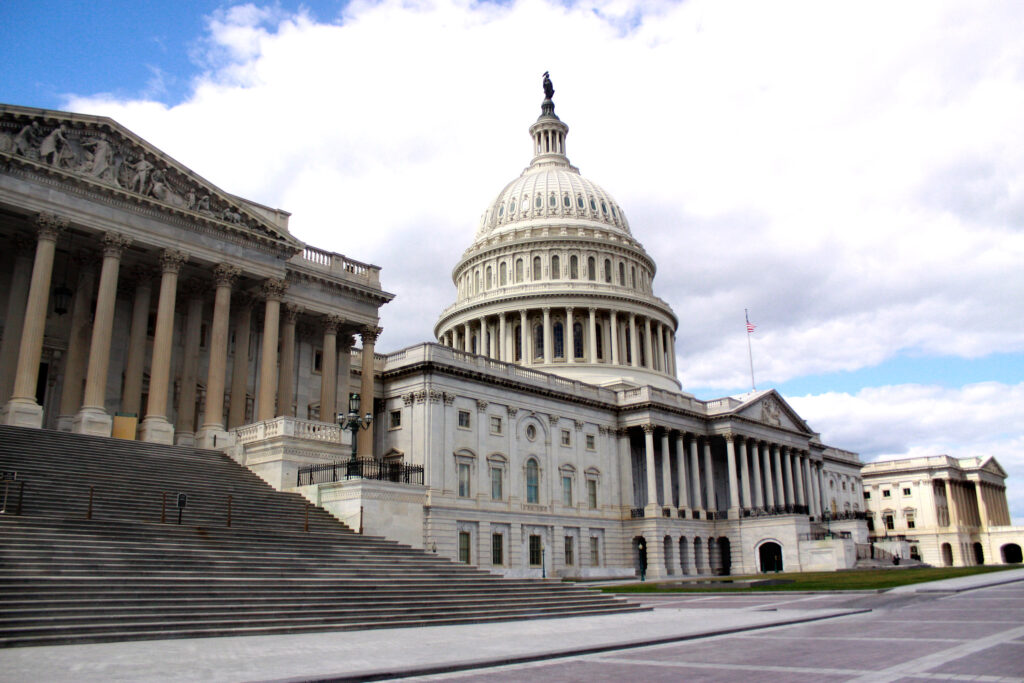
Pushback—or Cowardice?
Congress has responded—but often with all the spine of a damp paper towel.
A federal judge granted an injunction blocking the administration’s attempt to cap indirect costs on NIH grants, reinforcing that only Congress has the power to modify appropriations(Reuters). Yet congressional Republicans, who zealously guard their budgetary turf when convenient, have largely let this pass without a fight. They hold the power of the purse, but they refuse to use it. Instead, they’ve let Trump’s administration impose sweeping research funding cuts, gutting decades of bipartisan investment in American science. At best, their response is weak. At worst, they handed Trump the scalpel and looked away.
A few Republicans broke ranks. The Planetary Science Caucus warned that proposed cuts would “terminate dozens of programs already well underway,” including Mars Sample Return spacenews.com.
Democrats, by contrast, pushed back harder. For example, House Appropriations Democrats launched hearings to investigate whether HHS and OMB froze grants unlawfully and imposed ideological restrictions (pharmaphorum.com). Meanwhile, in Senate hearings, Senator Patty Murray blasted the cuts as “a wrecking ball to our biomedical research enterprise.” Additionally, Senator Tammy Baldwin grilled NIH Director Jay Bhattacharya over the 40% funding slashes—calling them “ripping away lifesaving research.”
But state attorneys general delivered the strongest blow. California AG Rob Bonta and 22 others sued the Trump administration to stop the NIH research funding cuts, calling the actions unlawful and a direct threat to jobs, science, and public health.
Congress Could Still Step In to Block Research Funding Cuts
One fact remains: Congress controls the budget.
In the past, lawmakers have reversed even the harshest proposals—and they still have that power now. Although the FY2026 budget is still in flux, there’s time left to intervene and stop the most damaging research funding cuts.
Nevertheless, the administration’s message has been unmistakable. Rather than investing in America’s future, it is chasing short-term political wins. By framing NIH, NSF, NOAA, and NASA as bloated or wasteful, it is deflecting attention from the real value they provide.
In reality, these agencies form the backbone of modern life. Whether it’s the vaccines that protect us, the forecasts that warn us, or the clean tech that powers our economy—we depend on them daily.
If Congress fails to act, politically driven research funding cuts will do lasting damage. Far from reducing waste, they will gut the very institutions that keep Americans healthy, informed, and globally competitive.
The Choice Ahead: Stop Research Funding Cuts or Surrender the Future
The U.S. research community has survived political turbulence before. But this time is different. Resilience has limits—and this assault is testing every one of them.
What happens in the next few months will define our future. They’ll decide how prepared we are for the next pandemic, the next megafire, the next planetary mission. The stakes are existential. And the damage from today’s research funding cuts could take a generation to repair—if we ever recover at all.
We don’t innovate by slashing investment. Nor do we lead by sabotaging our own labs. Our choice is clear: we need to fuel discovery, or let it collapse.
A Personal Reflection About Research Funding Cuts
As a scientist, I’ve seen firsthand how U.S. research saves lives and shapes the world. Much of that work happens behind the scenes. Its breakthroughs arrive years later, quietly embedded in the systems we trust.
Now, that foundation feels like it’s cracking.
You might not notice the lost grant, the scrapped satellite, or the retired scientist. But you will notice the fallout when a storm warning comes too late, or when a promising drug never gets developed. That’s how science fades: not in a single blow, but through steady, invisible erosion.
One scientist called these research funding cuts “catastrophic.” Another warned of “an extinction-level event.” No one uses words like that lightly.
But we are not powerless. If researchers, students, voters, and citizens stand together we can still fight back. And we must.
How the Public Can Help Stop Research Funding Cuts
It’s easy to feel powerless when billion‑dollar budgets get slashed behind closed doors. But this fight is about the future of public health, climate resilience, biomedical breakthroughs, and the next generation of scientists. These research funding cuts can be stopped—but only if we act. Here’s how:
Speak Up Loudly and Relentlessly
Call your representatives. Email them. Show up at their offices, especially if you live in a red district. Demand full funding for NIH, NSF, NASA, and climate science. Tell them that these research funding cuts threaten your health, your community, and your country’s future.
Use social media: tag lawmakers, share details of research funding cuts, and spotlight affected researchers and students. Make it real and amplify the urgency.
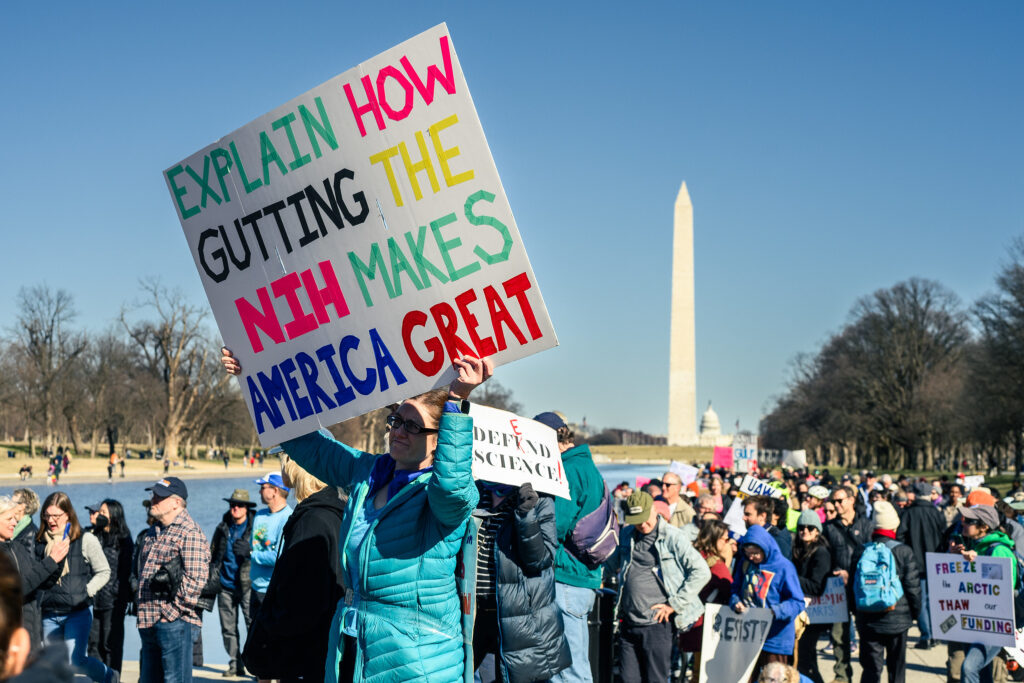
Stand on the Shoulders of Movement Momentum
- Stand Up for Science: Thousands gathered on March 7 across 30+ cities to defend academic freedom and and resist federal research funding cuts.
- No Kings Day (June 14): Over 5 million+ people across 2,000+ events joined the nationwide “No Kings” rallies in protest of authoritarian policies—likely the largest coordinated U.S. protest ever .
That momentum is a clear platform. Science advocacy must ride this wave and keep the energy alive.
Support Organizations Doing the Heavy Lifting
These organizations are already leading the charge against research funding cuts—and they need your help to keep going. Donate, volunteer, sign petitions, and share their campaigns. Be a force multiplier.
Mission: A nonprofit advocacy group that employs rigorous, independent scientific analysis to address climate change, protect public health, and promote evidence-based policymaking. UCS mobilizes scientists and grassroots supporters to influence policy at federal and state levels. They are on the front lines against science denial and research funding cuts.
Mission: Proudly nonpartisan, this movement champions science-informed public policy through rallies, educational events, and digital campaigns. Their goal: elevate the role of science in decision‑making and combat research funding cuts.
Mission: A consumer-advocacy nonprofit founded in 1971 by Ralph Nader, fighting for safer, healthier communities by challenging corporate influence, promoting democratic accountability, and supporting strong public protections—including defending against scientific research funding cuts.
Mission: A political action group dedicated to recruiting and supporting STEM professionals, including scientists, doctors, and engineers, to run for elected office. They work to ensure evidence-based leadership is represented at all levels of government.
Donate, volunteer, sign petitions, and share their campaigns—be a force multiplier.
Show Up in the Streets
Attend local rallies, town halls, and teach-ins. No event nearby? Host your own—a silent vigil, a lab walkout, or a community teach-in. Grassroots protests start small, and your leadership matters.
Pressure Institutions and Leadership
Are you at a university, research unit, or academic society? Push leadership to issue statements, file amicus briefs, and publicly defend scientific integrity. Silence is compliance—institutions have power, and they must use it.
Vote — And Help Others Vote
This fight spans years. Volunteer for voter registration campaigns. Elect science-minded candidates—not just federally, but in school boards, state legislatures, and local councils. Every level shapes science policy and funding.
Take Action Now
If you want to go beyond reading and do something today, here are concrete steps:
- Sign UCS’s petition to defend science — Join over 50,000 scientists and supporters demanding that Congress protect federal research funding.
- Join the March for Science mailing list — Sign up for updates on upcoming protests, webinars, and advocacy campaigns nationwide.
- Download Public Citizen’s organizing toolkit (PDF) — Get ready-to-use flyers, sample letters, media strategies, and more to organize local resistance.
- Explore 314 Action’s endorsed STEM candidates — Find science-minded candidates running at the state and local level, and help support their campaigns.
TL;DR: Resistance to Research Funding Cuts Is Rising
From Stand Up for Science in March to No Kings Day in June, millions have mobilized. By calling lawmakers, joining science advocacy groups, showing up at protests, pressuring institutions, and voting—we can and must defend science, academic freedom, and democracy. Importantly, the fight against research funding cuts is gaining momentum. So don’t sit this one out.
Your Thoughts
Now that you’ve read this, what do you think? For example, have you been impacted by research funding cuts? Or perhaps you have additional ideas on how to fight back. Moreover, how should scientists, students, and citizens respond? In addition, what local actions or advocacy efforts have inspired you? Please share your thoughts below.
Be sure to visit bleedingedgebiology.com next week for another “bleeding edge” topic!
Videos About Trump’s Massive Research Funding Cuts
How the Trump Administration is Dismantling Science.
This video explains in plain terms how proposed federal cuts threaten everything from climate monitoring to medical research. Experts break down the scale of the reductions and their real-world consequences. Watch to understand why scientists say these cuts could set U.S. innovation back decades.
Breaking Down the Massive Cuts to Science Funding
This clear explainer unpacks Trump’s proposed science budget cuts across NIH, NSF, NASA, and environmental research. It highlights which programs are on the chopping block and why experts are calling the cuts unprecedented. A must-watch for anyone who wants to see the big picture of these research funding cuts.
Scientists sound alarm on Trump administration’s dismantling of science
Scientists and policy experts speak out on the administration’s coordinated attack on U.S. science infrastructure. The video includes interviews with researchers facing layoffs and program closures. It powerfully illustrates the human cost of defunding scientific institutions.
Scientists warn Trump cuts to NIH funding could cost lives
NIH researchers speak out about the human cost of losing vital grants. This news segment shows how slashed funding stalls clinical trials and endangers new treatments. A sobering look at how political choices directly impact patients.
Nobel laureate on how Trump’s cuts are hurting science
A Nobel Prize–winning scientist lays out exactly how Trump’s cuts threaten U.S. research leadership. He connects budget decisions to lost medical breakthroughs and brain drain. This interview offers a compelling, expert-level warning on what’s at stake.
No Kings: Millions Across U.S. Protest Trump’s Power
See footage from the nationwide “No Kings Day” protests that drew millions into the streets. Activists call out authoritarian moves and stand up for academic freedom and democratic values. This video captures the energy and urgency of a growing movement resisting these cuts.

